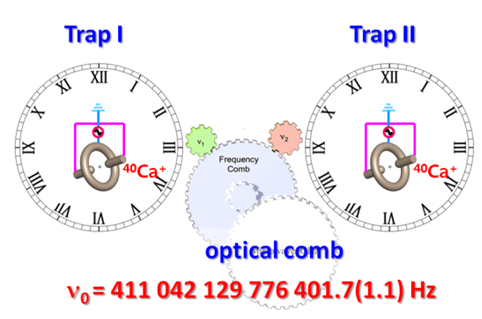At present, cold atomic optical frequency standards have highest accuracy among the atomic frequency standards. The new progresses are achieved by Prof. Kelin Gao’s group in WIPM. Two 40Ca+ optical frequency standards are realized and the frequency comparison between these two 40Ca+ optical frequency standards is completed. The results represent that the uncertainties and stabilities of two 40Ca+ optical frequency standards reach 10-17.
Before 2012, the group spent more than 10 years to solve a series of physical problems and key technologies, and realized the first 40Ca+ optical frequency standard in China with the precision of 7 x 10-16 in 2012, corresponding to 1 s error within 40,000,000 years.
Recently, Dr. Hua Guan and Dr. Yao Huang solved a series of key technologies, including the ultra-narrow linewidth laser, magnetic field control with high precision, etc. The second 40Ca+ optical frequency standard is realized. And the frequency comparison between two 40Ca+ optical frequency standards is carried out. Based on the frequency comparison, many frequency shifts are studied detailed, e. g. eliminating excess micromotion, ac Stark shift induced by lasers, electric quadrupole moment shift, blackbody radiation shift, etc. The accuracies of two optical frequency standards both reach 5´10-17, corresponding to 1 s error within 600,000,000 years. And the frequency stabilities of two optical frequency standards reach 7 x 10-17 at 20,000 s. Meanwhile, the absolute frequency of 4S1/2-3D5/2 transition of 40Ca+ is measured again, the transition frequency is measured using a comb referenced to a hydrogen maser, after which the hydrogen maser is calibrated via GPS referenced to UTC (NIM) using precise point positioning (PPP) data-processing technique. The result is 411 042 129 776 401.7(1.1) Hz. Those results show that Ca+ is after Hg+ (NIST), Al+ (NIST), Yb+ (NPL and PTB), and Sr+ (NPL and NRC) the fifth ion species with an estimated uncertainty below 10-17. The results are published on the Physical Review Letters
In Sep. 9th 2015, this absolute frequency result was accepted by CCTF 20 and updated the reference frequency of 40Ca+ 4S1/2-3D5/2 transition.
This project is supported by the National Basic Research Program of China, the National Natural Science Foundation of China and the Chinese Academy of Sciences. And this work is cooperated and supported with Prof. Longsheng Ma in ECNU and the Academician Tianchu Li in NIM.

The uncertainties and stabilities of two 40Ca+ optical frequency standards reach 10-17. The clock transition frequency is measured using a comb referenced to a hydrogen maser, after which the hydrogen maser is calibrated via GPS referenced to UTC (NIM) using precise point positioning (PPP) data-processing technique. The result is 411 042 129 776 401.7(1.1) Hz.